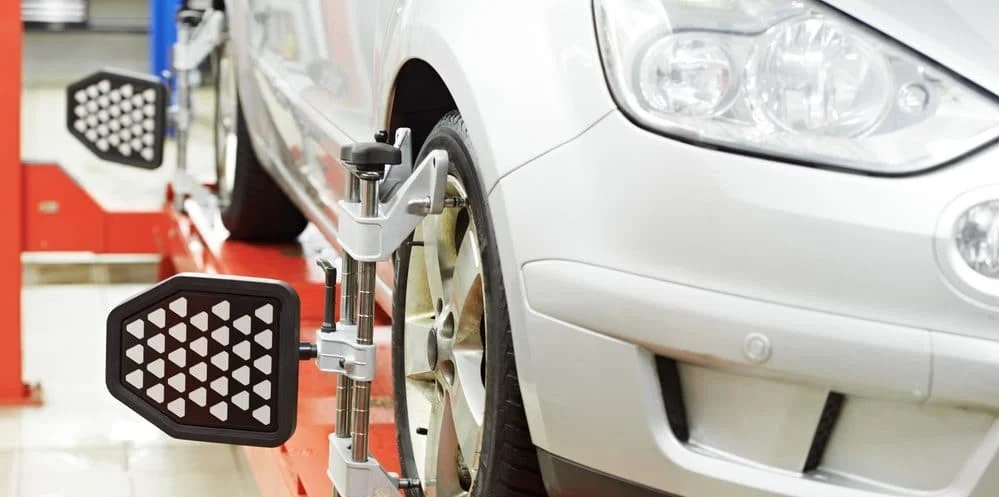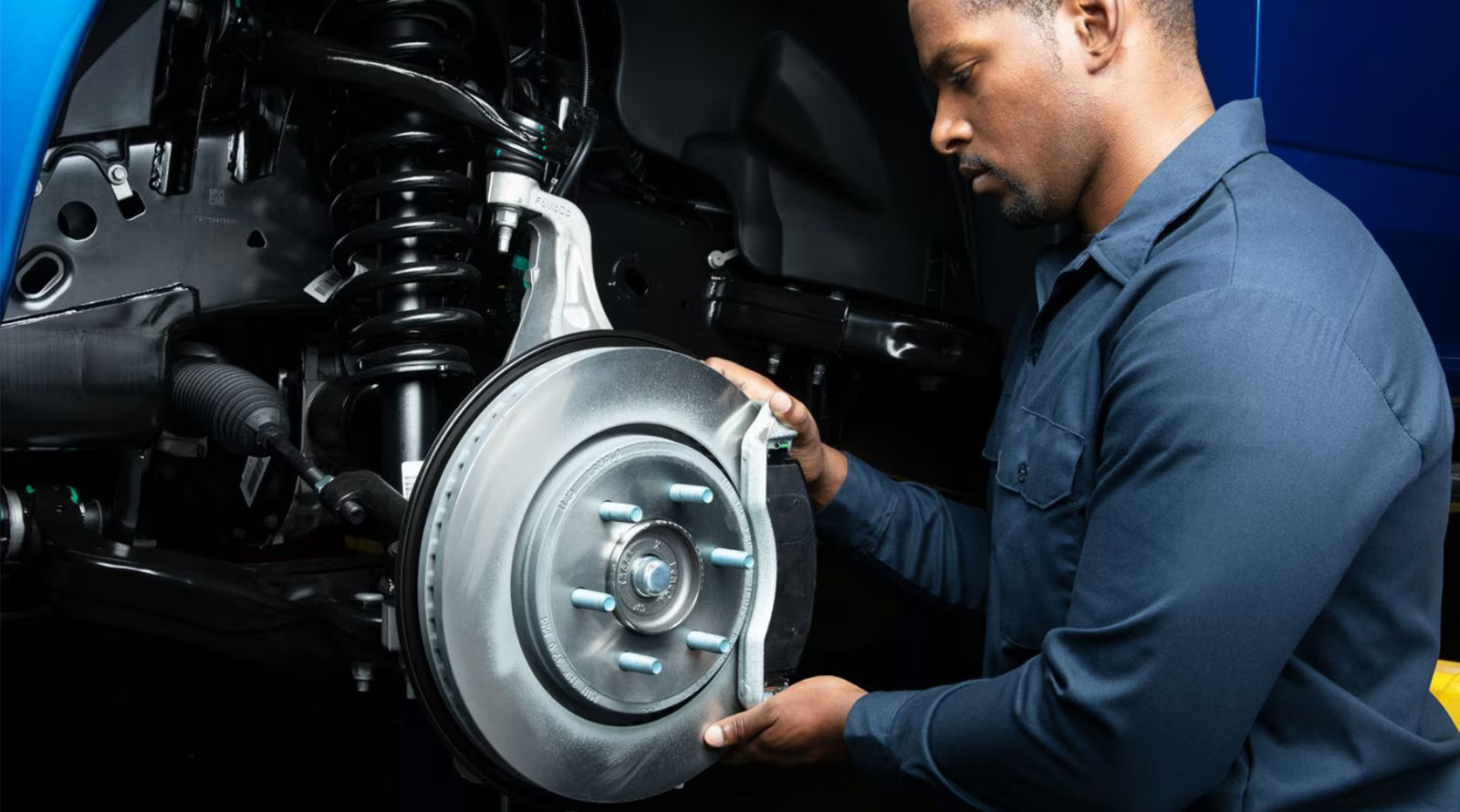When it comes to maintaining your Ford vehicle, two crucial aspects of wheel care often come into play: wheel balancing and wheel alignment. While these terms are sometimes interchangeable, they are distinct processes that serve different purposes in ensuring your vehicle’s optimal performance, safety, and longevity.

Wheel Balancing: Achieving Equilibrium
What is Wheel Balancing?
Wheel balancing is the process of evenly distributing the weight around a wheel and tire assembly. This procedure ensures that the wheel rotates smoothly at high speeds, without causing vibrations or uneven wear.
The Importance of Balanced Wheels
For Ford owners, properly balanced wheels are crucial for several reasons:
- Smooth Ride: Balanced wheels minimize vibrations, particularly at higher speeds, resulting in a more comfortable driving experience.
- Even Tire Wear: When wheels are balanced, the tire wear is distributed evenly, extending the life of your tires.
- Improved Fuel Efficiency: Balanced wheels reduce rolling resistance, resulting in improved fuel economy.
- Enhanced Safety: By reducing vibrations and improving stability, balanced wheels contribute to safer handling and braking.
The Wheel Balancing Process
When you take your Ford for wheel balancing, here’s what typically happens:
- Mounting: The wheel and tire assembly is mounted on a balancing machine.
- Spin Test: The machine spins the wheel at high speeds to detect any imbalances.
- Measurement: The machine measures the amount and location of the imbalance.
- Weight Application: Small weights are attached to specific points on the wheel to counteract the imbalance.
- Verification: They spin the wheel again to ensure they have achieved proper balance.
Signs Your Ford Needs Wheel Balancing
Watch out for these indicators that your wheels might need balancing:
- Vibration in the steering wheel, particularly at speeds between 80-110 km/h
- Uneven or faster tire wear
- Decreased fuel efficiency
- A bumpy or uncomfortable ride, especially on smooth roads
Wheel Alignment: Keep Everything in Line
What is Wheel Alignment?
Wheel alignment refers to the adjustment of the wheel angles so that they are perpendicular to the ground and parallel to one another. It involves adjusting the suspension components that connect the wheels to the vehicle.
The Importance of Proper Alignment
Correct wheel alignment is essential for:
- Even Tire Wear: Ensures that tires wear evenly, extending their lifespan.
- Improved Handling: Aligned wheels provide better steering response and overall handling.
- Fuel Efficiency: Reduces rolling resistance, improving fuel economy.
- Safety: Well-aligned wheels ensure that your vehicle tracks straight, enhancing safety, especially during emergency maneuvers.
The Wheel Alignment Process
When your Ford undergoes a wheel alignment, technicians typically:
- Inspection: Check the current angles and suspension components.
- Adjustment: Adjust the camber, caster, and toe angles as needed.
- Road Test: Perform a test drive to ensure the vehicle tracks straight and handles correctly.
Types of Wheel Alignment
Ford vehicles may require different types of alignment depending on their suspension design:
- Front-End: Focuses on adjusting the front wheels to ensure optimal alignment.
- Thrust-Angle: Ensures the rear wheels are parallel with the front wheels.
- Four-Wheel: Adjusts all four wheels, common in many modern Ford models with independent rear suspensions.
Signs Your Ford Needs Wheel Alignment
Look out for these indicators that your vehicle might need an alignment:
- Vehicle pulling to one side while driving on a straight, level road
- Uneven or rapid tire wear
- Off-center steering wheel when driving straight
- Squealing tires, especially when cornering
Compare Wheel Balancing and Alignment
While both procedures are crucial for performance, they address different aspects of wheel and tire maintenance:
Purpose
- Balancing: Ensures even weight distribution around the wheel.
- Alignment: Adjusts the angles of the wheels in relation to the road and each other.
Frequency
- Balancing: Typically needed every 10,000 to 20,000 kilometers or when installing new tires.
- Alignment: Generally required every 30,000 to 50,000 kilometres, or when replacing suspension components.
Effects
- Balancing: Primarily affects ride comfort and tire wear.
- Alignment: Impacts handling, tire wear, and overall vehicle control.
Equipment Used
- Balancing: Requires a wheel balancing machine.
- Alignment: Utilizes specialized equipment and often a vehicle lift.
Ford-Specific Considerations
Different Ford models may have unique requirements for balancing and alignment:
- Ford Focus and Fiesta – These compact models often require more frequent balancing due to their lighter weight and sensitivity to imbalances.
- Ford F-150 and Ranger – These trucks, especially when used for towing or off-roading, may need more frequent checks due to the increased stress on suspension components.
- Ford Mustang – Performance models like the Mustang greatly benefit from precise alignment, particularly when used for track driving or high-performance applications.
- Ford Explorer and Edge – These SUVs, with their higher center of gravity, rely on proper alignment for optimal handling and safety, especially in emergency maneuvers.
Maintenance Tips for Ford Owners
To keep your wheels in top condition:
- Regular Inspections: Check your tires monthly for uneven wear patterns.
- Rotate Tires: Follow the recommended tire rotation schedule, typically every 8,000 to 10,000 kilometers.
- Proper Inflation: Maintain the correct tire pressure as specified in your Ford manual.
- Avoid Potholes: Be cautious of road hazards that can throw off your alignment or damage wheels.
- Professional Check-ups: Have your wheels balanced and alignment checked during regular service intervals.
The Impact of Technology
Modern Ford vehicles often come equipped with advanced driver assistance systems (ADAS) that rely on precise wheel angles. These systems, such as lane-keeping assist and adaptive cruise control, may require special procedures to ensure they function correctly.
Maintain The Performance Of Your Ford
Understanding the difference between wheel balancing and alignment is crucial for maintaining your performance, safety, and efficiency. While balancing ensures smooth rotation and even tire wear, alignment ensures your vehicle tracks straight and handles properly. Regular attention to both these aspects of wheel care will not only enhance your driving experience but also extend the life of your tires and suspension components.
By staying vigilant for signs of imbalance or misalignment and adhering to the recommended maintenance schedules, you can keep your vehicle running smoothly for years to come. Remember, when in doubt, consult with a certified Ford technician who can provide model-specific advice and perform these crucial services with precision.
—
Frequently Asked Questions
How often should I have my Ford wheels balanced?
- Generally, it’s recommended every 10,000 to 20,000 kilometers or when you notice vibrations. However, if you frequently drive on rough roads, you might need to balance more often.
Can wheel alignment affect my Ford fuel efficiency?
- Yes, it can improve fuel efficiency. When wheels are misaligned, they create more rolling resistance, which forces the engine to work harder and consume more fuel.
Will I need a wheel alignment after replacing my Ford tires?
- While not always necessary, it’s often a good idea to get a check after installing new tires. This ensures optimal performance and wear of your new tires, especially if it’s been a while.
How does wheel balancing differ for alloy wheels on high-performance Ford models?
- Alloy wheels, often found on performance models like the Mustang, may require more precise balancing due to their lighter weight and the higher speeds at which these vehicles frequently travel. Some high-performance wheels might need specialized balancing techniques.
Can hitting a pothole throw off my Ford wheel alignment?
- Yes, hitting a pothole, curb, or other road hazards can affect your wheels. If you notice any changes in your vehicle’s handling after such an incident, it’s wise to have your angles checked.
Are there any signs that indicate I need both wheel balancing and alignment?
- If you’re experiencing a combination of symptoms, such as vibrations at high speeds, uneven tire wear, and your vehicle pulling to one side, you may need both services. A professional inspection can determine the exact needs of your Ford.
How does the Ford Electronic Stability Control (ESC) system interact with wheel alignment?
- It relies on properly aligned wheels to function optimally. Misaligned wheels can cause the system to work harder or less effectively, potentially compromising safety features like traction control and anti-lock braking.
Is it normal for new tires on my Ford to need balancing more frequently?
- New tires might need rebalancing after the first 1,000 to 2,000 kilometers as they “settle” and wear in. After this initial period, they should maintain their balance for longer periods, assuming normal driving conditions.
How do larger wheels and tires, like those on a Ford F-150, affect balancing and alignment needs?
- Larger wheels and tires can be more susceptible to imbalance due to their increased weight and size. They may also put more stress on suspension components, potentially requiring more frequent checks.
Can I perform wheel balancing or alignment at home on my Ford?
- While you can do basic tire rotation at home, aligning and balancing require specialized equipment and expertise. It’s best to have these services performed by trained professionals to ensure accuracy and safety, especially given the complex suspension systems in modern vehicles.



